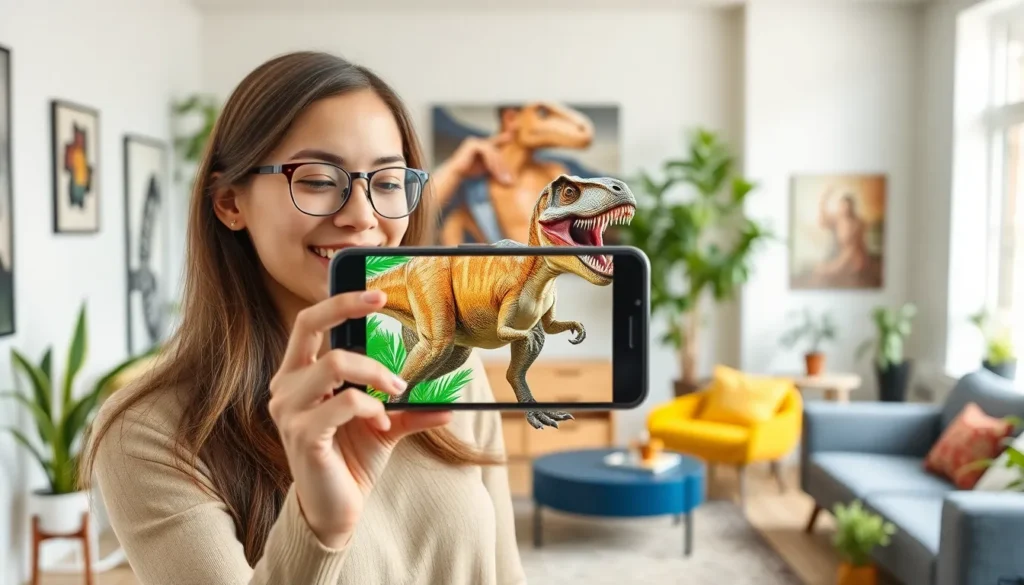Imagine stepping into a world where your living room transforms into a dinosaur park or your coffee table becomes a portal to ancient ruins. With augmented reality (AR) apps for Android, the mundane becomes magical. These apps blend the digital and physical worlds, making everyday experiences more interactive and fun.
AR Apps for Android
AR apps for Android redefine user engagement by merging virtual elements with real-world scenarios. These applications leverage the device’s camera and sensors to overlay digital content on physical environments. Developers create various categories of AR apps, including gaming, education, and interior design.
Gaming apps like Pokémon GO exemplify AR’s potential, allowing users to catch virtual creatures in their surroundings. Educational applications use AR to visualize complex concepts, enhancing learning experiences. For instance, apps like Google Translate enable users to point their camera at text and receive instant translations overlaid on the original content.
Unique features make these AR apps appealing. Real-time interaction allows users to manipulate digital objects within their physical space. High-quality graphics bring virtual elements to life, making experiences feel immersive. Additionally, social integration turns AR apps into platforms for shared experiences, with users interacting with friends in enhanced environments.
Market statistics indicate a growing demand for AR technology. Reports show that the AR app market is expected to reach a valuation of approximately $198 billion by 2025. A significant portion of this growth relates to consumer interest in engaging, interactive experiences.
Accessibility plays a crucial role in AR app adoption. Android’s large user base facilitates widespread use of these applications across diverse demographics. Increased smartphone capabilities enhance performance, ensuring users enjoy seamless experiences. Furthermore, as technology evolves, more developers invest in AR projects, promising innovative applications for the future.
Overall, AR apps for Android transform everyday interactions, providing users with captivating and interactive experiences that blend seamlessly with their environment.
Popular AR Apps in 2023

Many AR apps for Android captivate users by blending interactive experiences with real-world environments. Below are some key categories highlighting innovation in augmented reality.
Gaming Apps
Gaming AR apps like Pokémon GO remain popular in 2023. These apps engage players by integrating digital creatures with local environments, creating an immersive experience. Ingress Prime challenges users to explore outdoor spaces while capturing virtual points of interest. Other games, such as Jurassic World Alive, allow players to interact with dinosaurs in their own backyards, enhancing the excitement of gameplay. Data shows that gaming remains the leading sector for AR app downloads, showcasing the technology’s potential to revolutionize how people play.
Educational Apps
Educational AR apps transform learning experiences. Google Translate offers instant translations by overlaying text onto real-world objects, facilitating language comprehension. Apps like AR Flashcards enhance children’s learning by bringing educational content to life through interactive visuals. The use of AR in classrooms has been shown to improve retention rates for complex subjects, including science and mathematics. Teachers increasingly adopt these tools to make lessons more engaging and accessible, reflecting a growing trend in educational technology.
Utility Apps
Utility AR apps streamline everyday tasks and enhance productivity. Apps like IKEA Place let users visualize furniture in their own homes before making a purchase, simplifying the decision-making process. Google Lens functions as a powerful tool for identifying objects, translating text, and scanning barcodes in real-time. These applications leverage AR technology to provide practical solutions, helping users make informed choices quickly. Reports indicate utility apps are gaining traction as consumers seek tools that integrate seamlessly into daily life.
Features to Look for in AR Apps
Selecting the right AR app hinges on understanding key features. Several aspects enhance user experiences and overall satisfaction.
Compatibility
Compatibility ensures seamless functioning across various devices. Look for apps that support a broad range of Android versions, maximizing accessibility for users. Some AR apps leverage hardware advancements in newer devices, while others prioritize earlier Android iterations. Enhanced compatibility expands potential user bases and encourages broader engagement.
User Interface
User interfaces play a crucial role in app attractiveness. An intuitive interface aids navigation and encourages prolonged usage. Consider apps that implement clear icons, simple menus, and engaging visuals. A clean layout allows users to focus on AR experiences without distraction. Effective design elements increase user satisfaction and overall immersion.
Performance
Performance directly impacts the experience within AR environments. Smooth graphics and quick load times enhance user engagement. Apps that optimize for device capabilities deliver superior experiences. Look for those utilizing efficient algorithms to reduce lag and boost responsiveness. High-performance apps create seamless interactions, making augmented experiences more enjoyable.
Future Trends in AR Technology
Emerging trends indicate that AR technology will continue to evolve rapidly. Enhanced user experiences feature prominently, focusing on increased personalization and interactivity. Developers leverage artificial intelligence to create more sophisticated AR applications, tailored to individual preferences and behaviors.
Improved hardware capabilities also play a significant role. Modern smartphones already include advanced sensors and high-resolution displays, enabling richer AR experiences. 5G networks, expected to expand globally, will provide faster data speeds, improving real-time rendering of augmented environments.
In the realm of industry, AR applications are transforming sectors such as retail and healthcare. Retailers integrate AR for virtual try-ons, allowing customers to visualize products in real-time before purchasing. Similarly, healthcare professionals utilize AR for training and surgical simulations, enhancing both learning and patient outcomes.
Social media platforms incorporate AR features to engage users creatively. Filters and interactive experiences have become standard, encouraging content creation and sharing. Expect more platforms to explore AR tools, increasing user interaction and platform loyalty.
Gamification in education presents another promising trend. Learning apps increasingly use AR to foster engagement in complex subjects. By visualizing concepts interactively, learners retain information more effectively, bridging gaps in understanding.
Market growth continues to attract investment. The AR app market is projected to reach approximately $198 billion by 2025, reflecting substantial consumer interest. Developers can capitalize on this trend by focusing on innovative, practical applications that meet everyday needs.
Developments in AR glasses and wearables also show potential for the future. These devices promise hands-free interactions, enabling seamless integration of AR into daily life. As technology advances, user adoption is expected to increase, making AR more ubiquitous.
Innovations and emerging trends will likely dictate the trajectory of AR technology. Industry professionals must remain adaptable, anticipating user needs and technological advancements.
Conclusion
The evolution of AR apps for Android is revolutionizing how individuals interact with their surroundings. By blending the digital and physical worlds, these applications enhance everyday experiences and open new avenues for engagement. As technology advances, the potential for AR in various sectors continues to expand, promising even more innovative applications.
With a growing demand for immersive experiences and practical solutions, AR apps are set to become an integral part of daily life. Users can look forward to increasingly personalized and interactive applications that make tasks easier and more enjoyable. The future of AR on Android is bright, paving the way for exciting developments that will further enrich user experiences.



